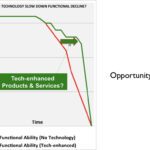By: Richard Caro | Posted: January 11, 2021 | Updated: April 5, 2023
Photo by Kelly Sikkema
There are a lot of things that have been memorable about 2020. Many of them have been pretty horrible.
But, in the area of innovation as it relates to the lives of older adults, we actually see some positive developments, and room for optimism about the future.
When looked at through the lens of “Technology for Older Adults“, we think the year will stand out as a bit of an inflection point in several ways.
- This was the year for “Virtual Interaction”. And many older adults were enthusiastic adopters. The key was “motivation”.
- We saw an acceleration, and hopefully a cementing, of a trend that started a few years ago: the convergence of “consumer products” and “products for the elderly”. Instead of “boring, beige, stigmatizing, special purpose products for old people”, increasingly the interesting innovations are “trendy consumer products that happen to incorporate features especially useful for older adults”.
- A handul of new product innovations are starting to emerge in product categories that were previously stagnant (like mobility assistive devices).
This article expands on these themes.
The Backdrop: COVID and Impact on Older Adults
You can’t write about 2020 without mentioning COVID.
The key aspects of relevance to this article were as follow.
- Everyone, including older adults, has been far more isolated than before. There has been a widespread and much discussed migration to virtual interactions online (especially video).
- Older Adults as a broad demographic have been especially “at risk”. So self-imposed isolation has likely been more extreme than for other groups of society.
- For older adults living in senior living facilities, the traditional bargain — in which you trade some autonomy for enhanced safety and more social interactions — seems less compelling than in the past to some. We think this will create a variety of opportunities for new and better products and business models going forward. Stay tuned for more on this from Tech-enhanced Life (Subscribe to get updates).
Virtual Interaction
Widespread adoption of virtual interaction is one of the most notable aspects of 2020. Time will tell if it is temporary or here to stay.
Here are some consequences and learnings.
The Importance of Motivation
As we converted our Longevity Explorer circle meetings from face-to-face to virtual interactions, we observed a very interesting thing.
Almost all the Longevity Explorers — older adults with ages ranging from 60-100 yrs old — adapted to using Zoom without too much difficulty. In fact, many of them commented that this was “even better” than face-to-face (less travel, easier to see and hear everyone).
Among the Longevity Explorers, there is a broad spectrum of technical ability. Some are extremely tech-savvy, and of course these people had no trouble adopting Zoom and other video calling techniques, and many already used such techniques.
But there are a lot of the explorers who in years past would have said they had no interest in video calls, either because they disliked the idea in principle or because it just seemed too foreign, or too hard.
What we noticed during COVID was that the vast majority of these people adopted Zoom. Some needed some help learning it. But the key was, now they were really motivated (due to isolation and a changed world). And with the right motivation, and some appropriate help, almost all of them adapted.
This has profound concequences for other products, I think. The key learning:
People will adopt things, even if they are not “perfect”, or “easy to use”, so long as they are super motivated as a result of the product meeting an important unmet need they have.
This is not to say that ease of use is unimportant. On the contrary, it is very important.
BUT, it’s key to be solving a problem people feel really motivated to “fix”.
(OK, this is not a new insight. But it was interesting to see such a profound example).
Virtual Interaction Products are Booming
Anyone who reads the business pages of a newspaper/ news website knows that Zoom has had a large increase in users in 2020.
But virtual interaction products take a variety of forms, of which Zoom, Facetime, and their peers (video call apps) are just one type. The other types of virtual interaction products include senior tablets, special purpose interaction devices, voice activated products with screens, and several other categories — discussed in detail, with mentions of specific products, in these Tech-enhanced Life articles: Best Video Call Technology, Virtual Connections to the Tech-Challenged, and Best Senior Tablet.
We know for a fact that business is booming for a number of these companies, and suspect that this is likely the case for all of them.
Connecting to the Remote Parent: a “Killer App”?
A common scenario this year is the one in which an older adult is no longer able to receive visits from family members. This can be because they live at a distance, or because the older adult is “locked down”.
We have seen a big increase in “enquiries for help” from the adult children of these isolated older adults, trying to figure out how to find the right virtual interaction tool, get it set up in advance, and have it deployed into wherever their parent lives — despite not being able to set it up for them at their home.
Our overview “Virtual Connections to the Tech-Challenged” is the place to start if you fit this category.
“Technology for the Elderly” & “Consumer Products” Converge
There is a whole category of products which we think of as “Products for the Elderly“. Think walkers, canes, hearing aids, incontinence supplies, and medical alerts (“I’ve fallen and can’t get up”).
The hallmark of this product category is a focus on frailty, being cared for, disability, and helplessness. Historically, most of the products in this category have been ugly, and are considered by many to be stigmatizing.
Unsurprisingly, many older adults when asked about these products say “I’m not ready for that yet”.
In contrast, there are conventional consumer products — which are actually “aspirational”. Think: the latest gadget from Apple, Fitbit, or any one of a number of youth-focused, consumer electronics companies. Think: electric cars from Tesla, or shoes from Allbirds.
When you talk with older adults about these products, the reaction is more likely to be “That looks “cool”. My granddaughter has one of those. But what would I do with that?”
Until a couple of years ago, these trendy aspirational products focused entirely on the needs of a younger demographic. And they were often designed in ways that made them confusing or hard to use for older adults who may have hearing or vision imperfections (think tiny light grey fonts on a white background).
Starting a couple of years ago, we started to see a big sea change: the emergence of products that were primarily aspirational consumer products — but which added some really useful features that were especially relevant to older adults.
Medical Alerts
The poster child for this is the smart watch.
In late 2018, we wrote an article in which we looked at the emergence of smart watches that incorporated some of the features of a medical alert. The classic example is the Apple Watch, but there are others.
Since then, the features available have improved, and interest among older adults has increased to the point that smart watches are serious competitors to conventional medical alerts in many (not all) life situations.
The big draw of this type of “aspirational product with useful features for older adults” is that it is something people actually want to wear. It’s hard to overstate the importance of this.
- See “Smartwatch as Medical Alert” for more on this topic.
In 2020, we saw this trend gain traction, with various media mentions; increased interest in products like the Apple Watch among older adults (and their adult children); and expansion of smart watch features to include other “older adult” use cases (like location tracking).
Voice (Alexa)
A second area exhibiting this convergence of consumer products and tech for older adults is “voice”.
Back in 2017, when the Longevity Explorers first got interested in voice activated assistants like Alexa, and other artifical intelligence (AI) solutions, many thought they were a novelty. But some of the explorers were quite passionate about Alexa and described use cases that they considered important. [For details, see Amazon Echo and Alexa for the Elderly].
Since then, Amazon added a screen, and enabled features like “drop ins”.
When we first explored the Echo Show in early 2019, these features led us to write “Alexa has matured from an AI that can do simple tasks, and with whom you can interact, to an AI that ALSO helps you interact with other humans.”
In 2020, that capability of facilitating remote interactions has been extremely valuable.
As a next step, in late 2020, Amazon added some extra features of relevance to older adults — the Alexa Care Hub, for example.
At this point, voice activated products like Alexa and its competitors from Google and Facebook can do quite a lot of things of especial value to older adults. But these are not “products for old people”. Instead, they are aspirational and trendy mainstream consumer products.
When “grannie” gets an Alexa, she and her grandchild can compare notes about what they use Alexa for.
This is an important sea-change.
What is especially interesting to us about the whole field of AI and older adults (voice-activated, but not only voice activated) is that, so far, we seem to be just scratching the surface in terms of its potential.
If you make a list of all the interesting things AI “could do” that would benefit older adults, and compare it with “what AI does today”, there are some big gaps. Some of these relate to the stage of technical development of the field of artifical intelligence, but some are “good ideas, just waiting to be executed”.
It seems reasonable to think that in the not too distant future more of the intriguing “possibilities” of AI will make it to market.
To learn more, see our Topic Hub: Smart Home, Artifical intelligence, Robots.
Vision & Hearing
We think both vision and hearing are categories that are ripe for innovation, and we are seeing some of it already.
These categories are both, in our opinion, places where the convergence of consumer electronics and “products for older adults” is starting to take hold, and will likely become increasingly important in the future.
We are not ready to call out specific products or specific use cases yet, but stay tuned as we work more on this going forward. (join our newsletter to learn when we publish new material in this area).
Technology for “Seniors”: Some Innovation
Even in product categories that are still primarily defining themselves as “Products for Seniors”, we are starting to see some long overdue signs of innovation making their way to market.
In this section we highlight some promising product innovations that have emerged in the last couple of years, and which in 2020 seemed to be gaining some real traction.
NOTE: While for some of these products we have done extensive hands-on evaluation and can talk authoratitively about strengths and weaknesses, some of the others are products that have made it past our Longevity Explorer screen of “looks interesting, useful, and novel”, but have not had the same rigorous evaluation by us. Bear this in mind as you read on. If you are interested in a specific product, follow the links to see the entry in our listing database, where you will also see any detailed reviews or evaluation done by the Tech-enhanced Life community or our analyst team.
The links below go to our listing database, where you can see pictures of the products, and learn more, as well as find links to the manufacturer’s websites — and in some cases access a discount code for Tech-enhanced Life readers.
Rollators and Walkers
It’s hard to think of a less aspirational “age-related product” than a walker (or its more mobile sibling the rollator).
Articles about age are often illustrated by the picture of a frail grannie, hunched over, and shuffling along behind a walker (a frame with wheels). Yet these products serve an important function: stability while moving, for those with balance problems and a variety of other issues.
There are several aspects of these products that have been obvious “opportunities for innovation” for years.
- many of them are very unattractive in appearance, and stigmatizing;
- using walkers and rollators seems often to lead people to develop a sort of stooped, hunched forward posture;
- many of them are quite limited as to the types of terrain they can be used on. They are often designed for a smooth flat surface, such as a linoleum floor.
We have noticed several promising new entrants into this category over the last year or two. We have not done hands-on evaluations of them, but they have been tried by various members of our Longevity Explorer community — who have reported back with enthusiasm.
The Rollator Reimagined
In 2020, there are several products that have tried to “reimagine” the traditional rollator.
- The Foray “Spring” (recently launched) is a very interesting looking rollator — specially designed to be more stylish, as well as to improve posture.
- The UpWalker has an unusual design, targeted at keeping people straight and upright.
I Want to be Free
For a certain type of older adult, there is strong desire not to be shackled by infirmity more than is essential. And so, this type of person might be forced to take advantage of the stability provided by a rollator, but wants to be able to “go where they want to”. You can see an eloquent discussion of this here.
You can now get an “all terrain” rollator, targeted at just this sort of person.
- One example, which some of our Longevity Explorers have bought and liked, is made by Volaris. See also the Veloped.
- While the Volaris and Veloped are fairly conventional rollators in concept, with extra all terrain features, there are some more “unusual” approaches to mobility tools emerging. For example, see the Alinker.
Medication Management
If you talk with clinicians involved with managing the health of older adults, adherence to the correct medication regimen is often on their list of “the top issues to address”.
Probably as a direct result of that, new “medication management products” appear frequently at innovation pitch fests and other gatherings of entrepreneurs.
In 2019 and 2020 we explored this space in great depth, doing hands-on evaluations of the most promising products. To see what we learned, see the collection of articles on our Topic Hub: Medication Management.
Here are some key learnings.
- There are some rather powerful medication management tools available now, ranging from a variety of reminder apps, to some simple pill organizing solutions, to some rather sophisticated robotic pill dispensers.
- While these products arguably do not do “everything” one might wish if the goal is to “solve the medication adherence challenge faced by clinicians”, they do rather a lot of pieces of it — and do them quite well.
The other big development in this product category over the last year or two was the rise of pre-packaged “daily packs of pills” for chronic medication use cases, with the most prominent competitor being PillPack (owned by Amazon).
And, in 2020 Amazon announced its entry into the pharmacy space on a much broader front than PillPack, which is likely to have some pretty impactful consequences.
What’s Next?
Interested in what comes next? To see what we learn as we explore this space further in the future:
*Disclosure: The research and opinions in this article are those of the author, and may or may not reflect the official views of Tech-enhanced Life.
If you use the links on this website when you buy products we write about, we may earn commissions from qualifying purchases as an Amazon Associate or other affiliate program participant. This does not affect the price you pay. We use the (modest) income to help fund our research.
In some cases, when we evaluate products and services, we ask the vendor to loan us the products we review (so we don’t need to buy them). Beyond the above, Tech-enhanced Life has no financial interest in any products or services discussed here, and this article is not sponsored by the vendor or any third party. See How we Fund our Work.



Wanted to give a big thank
Wanted to give a big thank you. Through your posts I learned about the Alexa show 8 and in spring 2020 I bought one for mom and one for me and it has been fantastic. Also bought one for a best friend whose health is a great worry to me. And now through you, I have learned about the Pillpack which I will investigate futher and it would be another benefit for mom. Had it not been for Tech-enhanced Life's research – I would NEVER have know about these things. Keep up the great work!